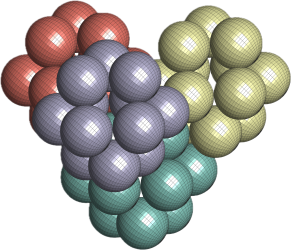I started work with only with one enclosing box and then to continue to build upon that.
I took one enclosing box and constructed a unit cell by surrounding this central box by other boxes (as is visualized in previous post). Next I “optimized” lattice energy by Lennard-Jones potential using the centers of mass of the CC3 molecule. The central cube can by moved in 3-directions (x,y,z) but out of symmetry it’s sufficient to move only in direction in this particular case. The center of mass of CC3 is slightly off the center of mass of the small cube. That means there are 16 rotations of the central cube that can be potential minima of the energy function.
The result can by seen by below. The dots are centers of mass of CC3. The minimum was attained with no rotation of the central small box.














































